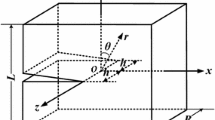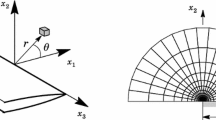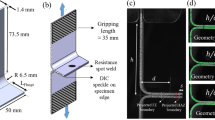Abstract
This work describes the development of an engineering approach based upon a toughness scaling methodology incorporating the effects of weld strength mismatch on crack-tip driving forces. The approach adopts a nondimensional Weibull stress, \({\bar{{\sigma}}_w}\), as a the near-tip driving force to correlate cleavage fracture across cracked weld configurations with different mismatch conditions even though the loading parameter (measured by J) may vary widely due to mismatch and constraint variations. Application of the procedure to predict the failure strain for an overmatch girth weld made of an API X80 pipeline steel demonstrates the effectiveness of the micromechanics approach. Overall, the results lend strong support to use a Weibull stress based procedure in defect assessments of structural welds.
Similar content being viewed by others
References
American Petroleum Institute (2005) Welding of pipelines and related facilities, 20th edn. API 1104
American Petroleum Institute (2007a) Fitness-for-service. API RP-579-1/ASME FFS-1
American Petroleum Institute (2007b) API specification for 5L line pipe, 44th edn
American Society of Mechanical Engineers (2004) Boiler and pressure vessel code. New York
American Society for Testing and Materials (2008a) Standard terminology relating to fatigue and fracture testing. ASTM E-1823, Philadelphia
American Society for Testing and Materials (2008b) Standard test methods for determination of reference temperature, T0, for ferritic steels in the transition range. ASTM E-1921, Philadelphia
American Welding Society (1987) Welding handbook: welding Technology, 8th edn, vol 1. Miami
Anderson TL (2005) Fracture mechanics: fundaments and applications. 3rd edn. CRC Press, New York
Averbach BL (1965) Micro and macro formation. Int J Fract Mech 1: 272–290
Bakker A, Koers RWJ (1991) Prediction of cleavage fracture events in the brittle–ductile transition region of a Ferritic steel. In: Blauel JG, Schwalbe KH (eds) Defect assessment in components—fundamentals and applications, ESIS/EG9. Mechanical Engineering Publications, London, pp 613–632
Beremin FM (1983) A local criterion for cleavage fracture of a nuclear pressure vessel steel. Metall Trans 14: 2277–2287
Brindley BJ (1970) The effect of dynamic strain-aging on the ductile fracture process in mild steel. Acta Metall 18: 325–329
British Standard (1991) Fracture mechanics toughness tests. BS 7448
British Standard Institution (2005) Guide on methods for assessing the acceptability of flaws in metallic structures, BS7910
Cravero S, Ruggieri C (2005) Correlation of fracture behavior in high pressure pipelines with axial flaws using constraint designed test specimens—part I: plane-strain analyses. Eng Fract Mech 72: 1344–1360
Det Norske Veritas (2007) Submarine pipeline systems. Offshore Standard OS-F101
Dodds RH, Shih CF, Anderson TL (1993) Continuum and micro-mechanics treatment of constraint in fracture. Int J Fract 64: 101–133
Dodds RH, Ruggieri C, Koppenhoefer K (1997) 3-D constraint effects on models for transferability of cleavage fracture toughness. In: Underwood JH (eds) et al Fatigue and fracture mechanics: 28th Volume, ASTM STP 1321. American Society for Testing and Materials, Philadelphia, pp 179–197
Donato GHB, Magnabosco R, Ruggieri C (2009) Effects of weld strength mismatch on J and CTOD estimation procedure for SE(B) specimens. Int J Fract 159: 1–20
Evans AG, Langdon TG (1976) Structural ceramics. Prog Mater Sci 21: 171–441
Feller W (1957) Introduction to probability theory and its application vol I. Wiley, New York
Freudenthal AM (1968) Statistical approach to brittle fracture. In: Liebowitz H (eds) Fracture: an advanced treatise vol II. Academic Press, NY, pp 592–619
Gao X, Ruggieri C, Dodds RH (1998) Calibration of Weibull stress parameters using fracture toughness data. Int J Fract 92: 175–200
Gao X, Dodds RH, Tregoning RL, Joyce JA, Link RE (1999) A Weibull stress model to predict cleavage fracture in plates containing surface cracks. Fatigue Fract Eng Mater Struct 22: 481–493
Gao X, Zhang G, Srivatsan TS (2005) Prediction of cleavage fracture in ferritic steels: a modified Weibull stress model. Mater Sci Eng A 394: 210–219
Glover AG, Hauser D, Metzbower EA (1986) Failures of weldments. In: Metals handbook, vol 11: failure analysis and prevention. American Society for Metals, pp 411–449
Gurland J (1972) Observations on the fracture of cementite particles in a spheroidized 1.05% C steel deformed at room temperature. Acta Metall 20: 735–741
Gullerud A, Koppenhoefer K, Roy A, RoyChowdhury S, Walters M, Bichon B, Cochran K, Dodds R (2004) WARP3D: dynamic nonlinear fracture analysis of solids using a parallel computers and workstations. Structural Research Series (SRS) 607. UILU-ENG-95-2012. University of Illinois at Urbana-Champaign
Hughes TJ (1980) Generalization of selective integration procedures to anisotropic and nonlinear media. Int J Numer Methods Eng 15: 1413–1418
Hutchinson JW (1983) Fundamentals of the phenomenological theory of nonlinear fracture mechanics. J Appl Mech 50: 1042–1051
Jutla T (1996) Fatigue and fracture control of weldments. In: ASM handbook, vol 19: fatigue and fracture. ASM International, pp 434–449
Kendall MG, Stuart A (1967) The advanced theory of statistics. 2nd edn. Hafner, New York
Kerr WH (1976) A review of factors affecting toughnness in welded steels. Int J Press Vessel Piping 4: 119–141
Lin T, Evans AG, Ritchie RO (1986) A statistical model of brittle fracture by transgranular cleavage. J Mech Phys Solids 21: 263–277
Lindley TC, Oates G, Richards CE (1970) A critical appraisal of carbide cracking mechanism in ferride/carbide aggregates. Acta Metall 18: 1127–1136
Mann NR, Schafer RE, Singpurwalla ND (1974) Methods for statistical analysis of reliability and life data. Wiley, New York
Matsuo Y (1981) Statistical theory for multiaxial stress states using Weibull’s three-parameter function. Eng Fract Mech 14: 527–538
Minami F, Brückner-Foit A, Munz D, Trolldenier B (1992) Estimation procedure for the Weibull parameters used in the local approach. Int J Fract 54: 197–210
Minami F, Ohata M, Toyoda M, Tanaka T, Arimochi K, Glover AG, North TH (1995) The effect of weld metal yield strength on the fracture behavior of girth welds in grade 550 pipe. Pipeline Technol 1: 441–461
Moran B, Shih CF (1987) A general treatment of crack tip contour integrals. Int J Fract 35: 295–310
Nevalainen M, Dodds RH (1995) Numerical investigation of 3-D constraint effects on brittle fracture in SE(B) and C(T) specimens. Int J Fract 74: 131–161
O’Dowd NP, Shih CF (1991) Family of crack-tip fields characterized by a triaxiality parameter: part I—structure of fields. J Mech Phys Solids 39(8): 989–1015
O’Dowd NP, Shih CF (1992) Family of crack-tip fields characterized by a triaxiality parameter: part II—fracture applications. J Mech Phys Solids 40: 939–963
Ruggieri C, Dodds RH (1996a) A transferability model for brittle fracture including constraint and ductile tearing effects: a probabilistic approach. Int J Fract 79: 309–340
Ruggieri C, Dodds RH (1996b) Probabilistic modeling of brittle fracture including 3-D effects on constraint loss and ductile tearing. J Phys
Ruggieri C (2001) Influence of threshold parameters on cleavage fracture predictions using the Weibull stress model. Int J Fract 110: 281–304
Ruggieri C (2009a) WSTRESS release 3.0: numerical computation of probabilistic fracture parameters for 3-D cracked solids. EPUSP, University of São Paulo
Ruggieri C (2009b) FRACTUS2D: numerical computation of fracture mechanics parameters for 2-D cracked solids. EPUSP, University of São Paulo
Ruggieri C, Gao X, Dodds RH (2000) Transferability of elastic-plastic fracture toughness using the Weibull stress approach: significance of parameter calibration. Eng Fract Mech 67: 101–117
Silva LAL, Cravero S, Ruggieri C (2006) Correlation of fracture behavior in high pressure pipelines with axial flaws using constraint designed test specimens—part II: 3-D effects on constraint. Eng Fract Mech 73: 2123–2138
Tetelman AS, McEvily AJ (1967) Fracture of structural materials. Wiley, New York
Thoman DR, Bain LJ, Antle CE (1969) Inferences on the parameters of the Weibull distribution. Technometrics 11: 445–460
Wallin K (1984) The scatter in KIc results. Eng Fract Mech 19: 1085–1093
Wallin K (2002) Master curve analysis of the Euro fracture toughness dataset. Eng Fract Mech 69: 451–481
Weibull W (1939) The phenomenon of rupture in solids. Ingeniors Vetenskaps Akademien Handl 153: 55
Weisstein EW (2009) “Ellipse” in mathWorld—a wolfram web resource. http://www.mathworld.wolfram.com/Ellipse.html
Author information
Authors and Affiliations
Corresponding author
Rights and permissions
About this article
Cite this article
Ruggieri, C. An engineering methodology to assess effects of weld strength mismatch on cleavage fracture toughness using the Weibull stress approach. Int J Fract 164, 231–252 (2010). https://doi.org/10.1007/s10704-010-9488-3
Received:
Accepted:
Published:
Issue Date:
DOI: https://doi.org/10.1007/s10704-010-9488-3




